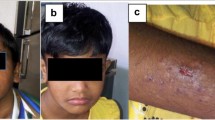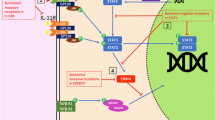Abstract
Hyper IgE syndrome (HIES) is a rare primary immunodeficiency disorder, characterized by eczema, recurrent skin and lung infections, and significantly elevated serum IgE level. It was previously diagnosed based on clinical manifestations and laboratory markers that were not specific to the disease. Recent studies have demonstrated that mutations in signal transducer and activator of transcription 3 (STAT3) cause the autosomal dominant or sporadic HIES, which make the disease definitively characterized at molecular level. Here, we reported a 3-year old Chinese boy with neonatal-onset rash and multiple serious Staphylococcus aureus infections including recurrent skin abscesses, liver abscess, sepsis, and destructive pulmonary infection (pneumonia, multiple pulmonary abscesses, pyopneumothorax, and finally, pneumatocele). Genetic study revealed a heterozygous mutation in exon 21 of STAT3 gene (g.66583 A > C, c.1970A > C) in the boy, which resulted in a substitution of tyrosine at the amino acid position 657 to serine (p.Y657S) in the Src homology 2 (SH2) domain of STAT3. Functional prediction with bioinformatics programs of the Sorting Intolerant from Tolerant (SIFT) and the Polymorphism Phenotyping (PolyPhen) reported “deleterious (SIFT score 0.02)” and “probably damaging (PSIC score difference 2.94)” values, respectively. Further study of family members revealed that neither his parents, nor his twin brother carried the mutation, indicating the mutation was likely to occur de novo in our patient. Conclusion: The mutation,p.Y657S,in SH2 domain of STAT3 is a disease-causing mutation in the boy with HIES.


Similar content being viewed by others
References
Buckley RH, Wray BB, Belmaker EZ (1972) Extreme hyperimmunoglobulinemia E and undue susceptibility to infection. Pediatrics 49:59–70
Davis SD, Schaller J, Wedgwood RJ (1966) Job's syndrome. Recurrent, “cold”, staphylococcal abscesses. Lancet 1:1013–1015
Engelhardt KR, McGhee S, Winkler S et al (2009) Large deletions and point mutations involving the dedicator of cytokinesis 8 (DOCK8) in the autosomal-recessive form of hyper-IgE syndrome. Allergy Clin Immunol 124:1289–1302.e4
Fanconi S, Seger RA, Willi U et al (1984) Oral chloramphenicol therapy for multiple liver abscesses in hyperimmunoglobulinemia E syndrome. Eur J Pediatr 142:292–295
Grimbacher B, Schäffer AA, Holland SM et al (1999) Genetic linkage of hyper-IgE syndrome to chrosome 4. Am J Hum Genet 65:735–744
Holland SM, DeLeo FR, Elloumi HZ et al (2007) STAT3 mutations in the hyper-IgE syndrome. N Engl J Med 357:1608–1619
Jiao H, Tóth B, Erdos M et al (2008) Novel and recurrent STAT3 mutations in hyper-IgE syndrome patients from different ethnic groups. Mol Immunol 46:202–206
Milner JD, Brenchley JM, Laurence A et al (2008) Impaired T(H)17 cell differentiation in subjects with autosomal dominant hyper-IgE syndrome. Nature 452:773–776
Minegishi Y, Karasuyama H (2007) Hyperimmunoglobulin E syndrome and tyrosine kinase 2 deficiency. Curr Opin Allergy Clin Immunol 7:506–509
Minegishi Y, Saito M, Tsuchiya S et al (2007) Dominant-negative mutations in the DNA-binding domain of STAT3 cause hyper-IgE syndrome. Nature 448:1058–1062
Minegishi Y (2009) Hyper-IgE syndrome. Curr Opin Immunol 21:487–492
Minegishi Y, Saito M, Nagasawa M et al (2009) Molecular explanation for the contradiction between systemic Th17 defect and localized bacterial infection in hyper-IgE syndrome. J Exp Med 206:1291–1301
Renner ED, Puck JM, Holland SM et al (2004) Autosomal recessive hyperimmunoglobulin E syndrome: a distinct disease entity. J Pediatr 144:93–99
Renner ED, Rylaarsdam S, Anover-Sombke S et al (2008) Novel signal transducer and activator of transcription 3(STAT3) mutations, reduced T(H)17 cell numbers, and variably defective STAT3 phosphorylation in hyper-IgE syndrome. J Allergy Clin Immunol 122(1):181–187
Roy AD, Mcllrath EM, Mawhinney H (1982) Multiple liver abscesses in a patient with hyper IgE syndrome. J R Coll Surg Edinb 27:224–227
Sass V, Schneider T, Wilmes M et al (2010) Human beta-defensin 3 inhibits cell wall biosynthesis in Staphylococci. Infect immune 78:2793–2800
Tangye SG, Cook MC, Fulcher DA (2009) Insight into the role of STAT3 in human lymphocyte differentiation as revealed by the hyper-IgE syndrome. J Immunol 182:21–28
Winkelstein JA, Marino MC, Johnston RB Jr et al (2000) Chronic granulomatous disease. Report on a national registry of 368 patients. Med Baltim 79:155–169
Woellner C, Gertz EM, Schäffer AA et al (2010) Mutations in STAT3 and diagnostic guidelines for hyper-IgE syndrome. J Allergy Clin Immunol 125:424–432.e8
Xu X, Kasembeli MM, Jiang X et al (2009) Chemical probes that competitively and selectively inhibit STAT3 activation. PLoS ONE 4:e4783
Zhang Q, Davis JC, Lamborn IT et al (2009) Combined immunodeficiency associated with DOCK8 mutations. N Engl J Med 361:2046–2055
Acknowledgments
Qiang Li has received a research funding from the Department of Science and Technology of Sichuan Province, China (No.2008JY0029-1). We deeply thank Professor Yu-lung Lau*, Professor Wen-wei Tu* and Dr.Koon-wing Chan* for their invaluable help (Qiang Li has received a 3-months training in molecular diagnosis of primary immunodeficiency disease in the Department of Paediatrics & Adolescent Medicine, Hong Kong University). We are also grateful to the patient and his parents for their cooperation.
*Department of Paediatrics & Adolescent Medicine, Hong Kong University.
Conflict of Interest Statement
Qiang Li has received research support from the Department of Science and Technology of Sichuan Province, China (No.2008JY0029-1). All authors declare that no actual or potential conflict of interest in relation to this article exists.
Author information
Authors and Affiliations
Corresponding author
Rights and permissions
About this article
Cite this article
Liu, Jy., Li, Q., Chen, Tt. et al. Destructive pulmonary staphylococcal infection in a boy with hyper-IgE syndrome: a novel mutation in the signal transducer and activator of transcription 3 (STAT3) gene (p.Y657S). Eur J Pediatr 170, 661–666 (2011). https://doi.org/10.1007/s00431-010-1349-6
Received:
Accepted:
Published:
Issue Date:
DOI: https://doi.org/10.1007/s00431-010-1349-6




